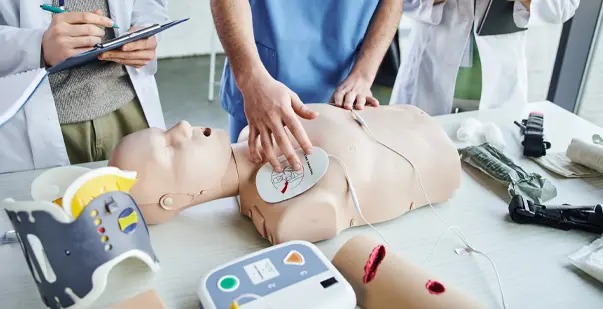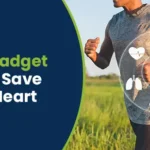Table of content
- Introduction
- What is the difference between pediatric and adult AED pads?
- What are the risks of using pediatric AED pads on an adult?
- Can you use pediatric AED pads on adults?
- When should you use pediatric pads on an adult?
- Conclusion
When you face a medical emergency, an automated external defibrillator can be a lifesaver. AEDs are crucial while saving a life during a sudden cardiac arrest emergency. These deliver a life-saving shock to the heart. This is why they have pads specifically designed for different age groups. But what happens if your AED does not have the right accessories to deliver the life-saving shock?
If pediatric pads are not available, you may have questioned, ‘can you use pediatric pads on adults?’ Is it safe, and if so, then under what circumstances?’ While it is always important to use the correct pads for the person’s age and size, it is also important to understand the safety and limitations. Keep reading the blog to learn how to apply electrode pads to children and infants.
Master ACLS Now
Get ACLS certified with confidence
What is the difference between pediatric and adult AED pads?
Here is a table outlining the difference between pediatric and adult AED pads:
| Aspect | Pediatric AED pads | Adult AED pads |
| Target age group | Designed for children under 8 years old | Designed for individuals 8 years and older |
| Energy Delivery | Delivers a reduced shock energy suitable for a child’s smaller heart and body | Delivers a full shock energy appropriate for an adult’s larger heart and body |
| Pad size | Smaller pads to fit a child’s body size | Larger pads to cover more surface area on an adult’s chest |
| Placement on body | Usually placed on the front and back of the torso to avoid overlapping | Placed on the front left side of the chest and on the right side below the collarbone |
| Cable length | Often shorter cables, as children have smaller bodies | Longer cables to accommodate the larger distance on an adult’s body |
| AED device settings | Some AEDs automatically adjust the energy level when pediatric pads are connected | Standard energy settings for adult defibrillation |
Read more: How To Get BLS Certification?
What are the risks of using pediatric AED pads on an adult?
Using pediatric AED pads leads to several risks. Pediatric pads lower energy shock, which may not be sufficient for an adult’s heart. Additionally, improper pad placement can reduce the effectiveness of defibrillation and delay critical treatment.
Here are the risks of using pediatric AED pads on adults:
- Insufficient energy delivery: Pediatric pads deliver lower energy shock appropriate for a child’s heart. When it is used on a child, the energy might not be enough to start the heart beating again. This can reduce the chances of survival and successful resuscitation.
- Ineffective placement of pads: adult AED pad placement is such that it does not match a child’s smaller body. These pads hence may not cover the adult’s body well, especially near the chest. This leads to ineffective delivery of shock. Improper placement can reduce the effectiveness and delay life-saving treatment.
- Potential for delayed response: Using pediatric pads on an adult may cause confusion, especially during emergencies. They must adjust settings and determine whether the shock will be effective or cause delay. During an emergency, every second counts, and this is a significant risk that might be harmful.
- Can cause electric burns: Pediatric pads are not just designed to handle the larger surface area and higher energy needs of an adult. When used on an adult, they do not match the energy levels. Hence, this can increase the risk of electrical burns. This may be traumatic for the patient.
Can you use pediatric AED pads on adults?
Yes, you can use pediatric AED pads on an adult during an emergency if adult pads are not available. Pediatric pads deliver lower energy shock, which may not be as effective as an adult’s. While using pediatric pads is better than not providing any shock, it is crucial to recognize that the treatment might be less effective. Adult pads must be used for adults to ensure the right energy level as delivered for successful resuscitation. Opt for pediatric pads as the last option.
When should you use pediatric pads on an adult?
In an emergency, using pediatric AED pads on an adult may be the only option available. Adult AED pads must be used for adults. However, when adult pads are not there, you must use pediatric pads rather than provide any treatment at all.
Here are a few scenarios where you might need it:
- Lack of adult pads: If only pediatric pads are available during a cardiac arrest, using them is better than not administering a shock. The lower energy shock may offer some benefit. It provides a life-saving opportunity while waiting for professional help.
- Remote or isolated locations: In isolated areas where there is no access to medical supplies, pediatric pads may be the option available. You must act quickly and use available resources to improve survival chances.
- Multiple victims: In situations where there are multiple victims, pediatric pads must be used on an adult to ensure everyone receives treatment. Delivering any shock is preferable and can help save a life.
- Unexpected equipment failure: If the equipment fails to perform, pediatric pads might be an excellent emergency backup. While the energy may be lower, it provides an immediate response, which can help maintain heart function.
Read more: CPR vs. BLS Training: What’s the Difference?
Conclusion
Using an AED in an emergency is life-saving, but you must follow proper guidelines to ensure safety and efficiency. Correct usage of AED ensures that shock is delivered well and that the bystanders are kept safe. Using AED pads for a child on an adult is better than providing no treatment at all. Pediatric pads deliver low energy shock, which may be less effective for an adult but still offers a critical chance for survival. Act swiftly in emergencies, so if adult pads are unavailable. Do not hesitate to use pediatric pads. Follow the prompt and seek help immediately.







